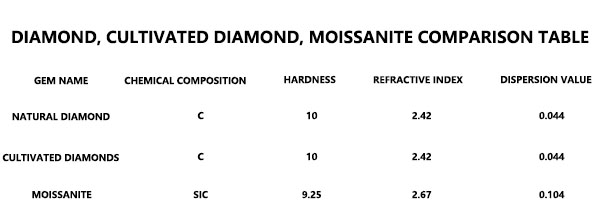Recently, many friends have asked, “Are lab-grown diamonds (man-made diamonds) just moissanite (silicon carbide)?” However, the answer is no, laboratory-grown diamonds (man-made diamonds) are not moissanite (silicon carbide)!
Moissanite, also known as moissanite, is actually a synthetic silicon carbide (chemical formula SiC). In 1893, French scientist Dr. Henri Mossian discovered silicon carbide in the canyon dark meteorite fragments in Arizona, USA, so this material was named “Moissanite” after Dr. Moissanite. In 1995, C3 Corporation of the United States introduced synthetic silicon carbide to the market. Natural moissanite is extremely rare, and the moissanite that can be seen on the market is basically synthetic. At the chemical cost of SIC, the refractive index is 2.67, the dispersion value is 0.104, and the hardness is 9.25. Moissanite is a diamond imitation currently on the market, close to the overall appearance of a diamond.

LABORATORY GROWN DIAMOND is a real diamond that is carefully cultivated by slowly growing the diamond layer as a crystal embryo, simulating the natural diamond growth environment, and reducing the diamond growth environment at a ratio of 1:1 in the laboratory. Both natural diamonds and artificially grown diamonds are pure carbon crystals with exactly the same physical and chemical properties. The chemical composition of natural diamonds and synthetic diamonds is a carbon (C), with a refractive index of 2.42, a dispersion value of 0.044, and a hardness of 10. In a nutshell, both are like ice that is naturally formed outdoors (natural diamonds) and ice that is made by an ice maker (grown diamonds). They are both ices but formed in different ways. Grown diamonds are shown on the report as laboratory-grown (man-made diamonds).
Many of the physical properties of moissanite are very similar to those of cultivated diamonds. Its density is slightly lower than that of a diamond, its hardness is second only to that of a diamond, its dispersion is even greater than that of a diamond, and its refractive index is also higher than that of a diamond, so Moissanite looks brighter than a diamond. But apart from the appearance of moissanite which looks very similar to diamonds, other physical and chemical characteristics have nothing to do with diamonds. Moissanite will be called Moissanite in the market, but you need to know that Moissanite will not be called diamond on the certificate, and the word diamond will not appear on the certificate. The certificate shows silicon carbide (synthetic silicon carbide).
